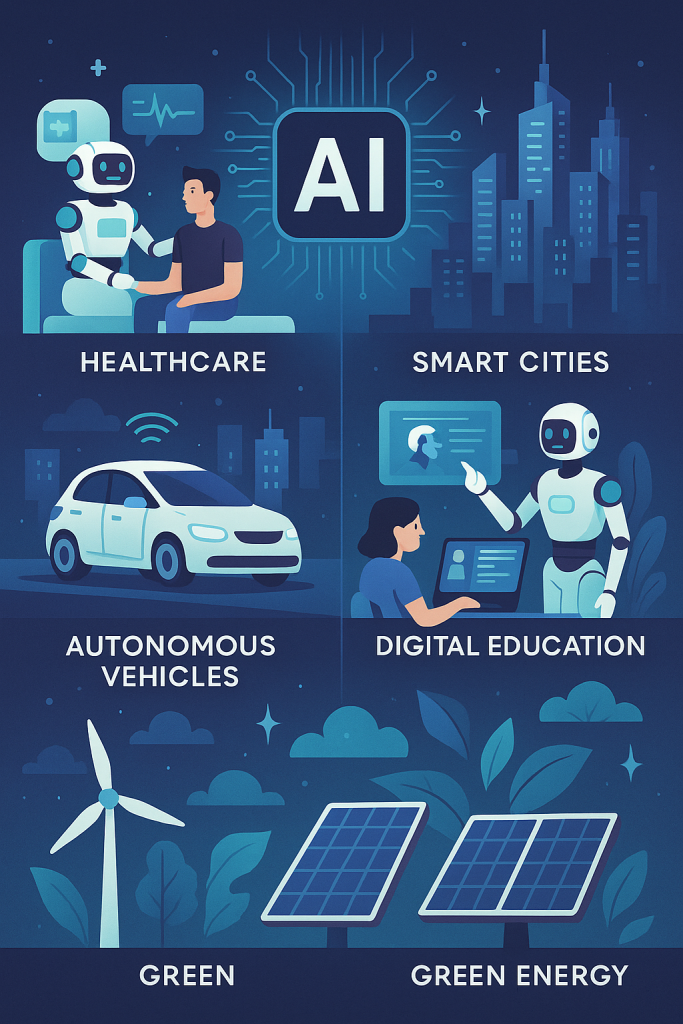The artificial intelligence revolution is accelerating at an unprecedented pace, fundamentally reshaping how we live, work, and interact with technology. As we stand at the threshold of 2025, AI has evolved from a futuristic concept to an integral part of our daily operations, with profound implications for global economic growth, industry transformation, and societal development.
The Current AI Landscape: From Experimentation to Integration
2025 marks a pivotal year for artificial intelligence – the transition from experimental deployment to enterprise-wide integration and optimization. According to recent industry analysis, over 78% of organizations now report using AI in at least one business function, representing a dramatic increase from just 55% in 20231. This shift signifies AI’s evolution from a novel technology to a strategic business imperative.
The generative AI boom, sparked by breakthroughs like ChatGPT and GPT-4, has fundamentally altered the AI landscape. Global AI venture capital funding reached a record $100 billion in 2024, nearly doubling from $55.6 billion in 2023, with AI startups capturing an unprecedented 46.4% of total U.S. venture capital investment. This massive influx of capital underscores investor confidence in AI’s transformative potential and commercial viability.
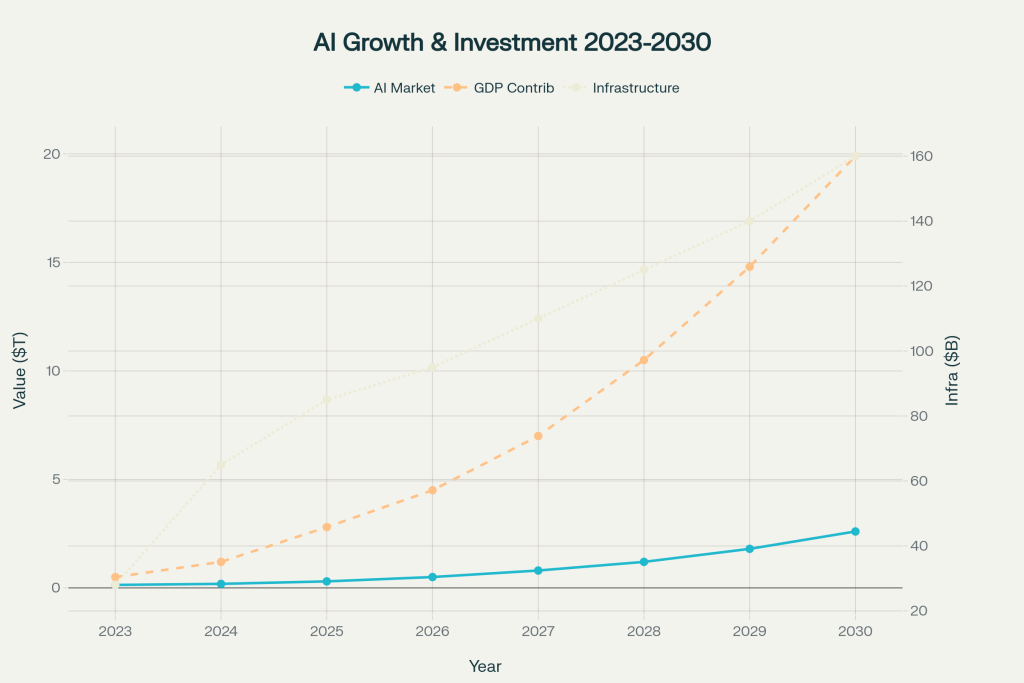
The Future of AI: Market Growth, Economic Impact, and Infrastructure Investment (2023-2030)
Economic Impact: AI’s Trillion-Dollar Transformation
The economic implications of AI adoption are staggering. Goldman Sachs Research forecasts that AI will begin having a measurable impact on U.S. GDP by 2027, with projections showing AI could ultimately automate around 25% of labor tasks in advanced economies. By 2030, AI is expected to contribute an estimated $19.9 trillion to the global economy, representing a compound annual growth rate that dwarfs most other technological revolutions in history.
Infrastructure investment is keeping pace with demand, with global AI infrastructure spending projected to exceed $100 billion by 2028. This massive investment in computing power, data centers, and specialized hardware reflects the enormous computational requirements of modern AI systems, particularly large language models and multimodal AI applications.
Key economic drivers include:
- Productivity gains: AI could increase U.S. productivity growth by 1.5 percentage points annually over a 10-year period4
- Cost reduction: Automation through AI is expected to drive significant labor cost savings while freeing workers for higher-value tasks
- Innovation acceleration: AI is enabling breakthrough discoveries in drug development, materials science, and climate solutions
- New market creation: Entirely new industries and business models are emerging around AI capabilities
Industry Adoption: Leading Sectors and Emerging Applications
AI adoption varies significantly across industries, with technology companies leading the charge at 92% adoption rates, followed by financial services at 87%6. However, even traditionally conservative sectors like healthcare (78%) and manufacturing (73%) are rapidly embracing AI technologies for competitive advantage.
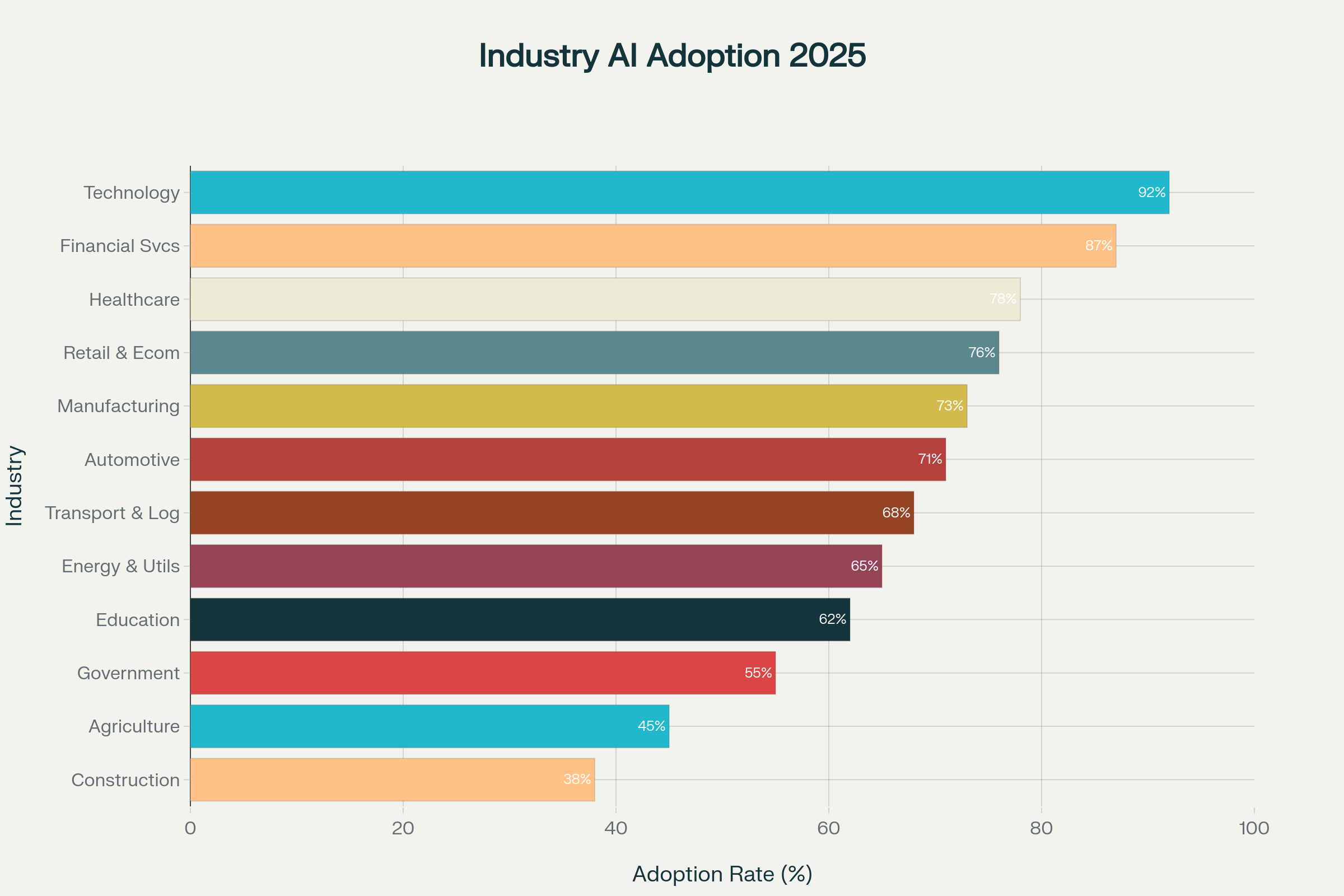
AI Adoption Across Industries: Current State and 2025 Projections
The healthcare sector exemplifies AI’s transformative potential, with AI-powered diagnostic tools now outperforming human specialists in specific applications. Machine learning algorithms can detect early signs of diseases like cancer and Alzheimer’s with unprecedented accuracy, while AI-driven drug discovery is reducing development timelines from 10 years to under 2 years in some cases7.
Manufacturing industries are leveraging AI for predictive maintenance, with algorithms analyzing equipment data to forecast failures before they occur, reducing downtime by up to 50% and extending machinery lifespan significantly6. This represents a fundamental shift from reactive to proactive maintenance strategies.
The Investment Landscape: Where Capital is Flowing
Infrastructure and foundation models dominate AI investment, capturing 37% of total funding in 2024, reflecting the enormous capital requirements for training and deploying large-scale AI systems2. Enterprise software and applications follow with 23%, while healthcare and life sciences command 15% of investment flows.
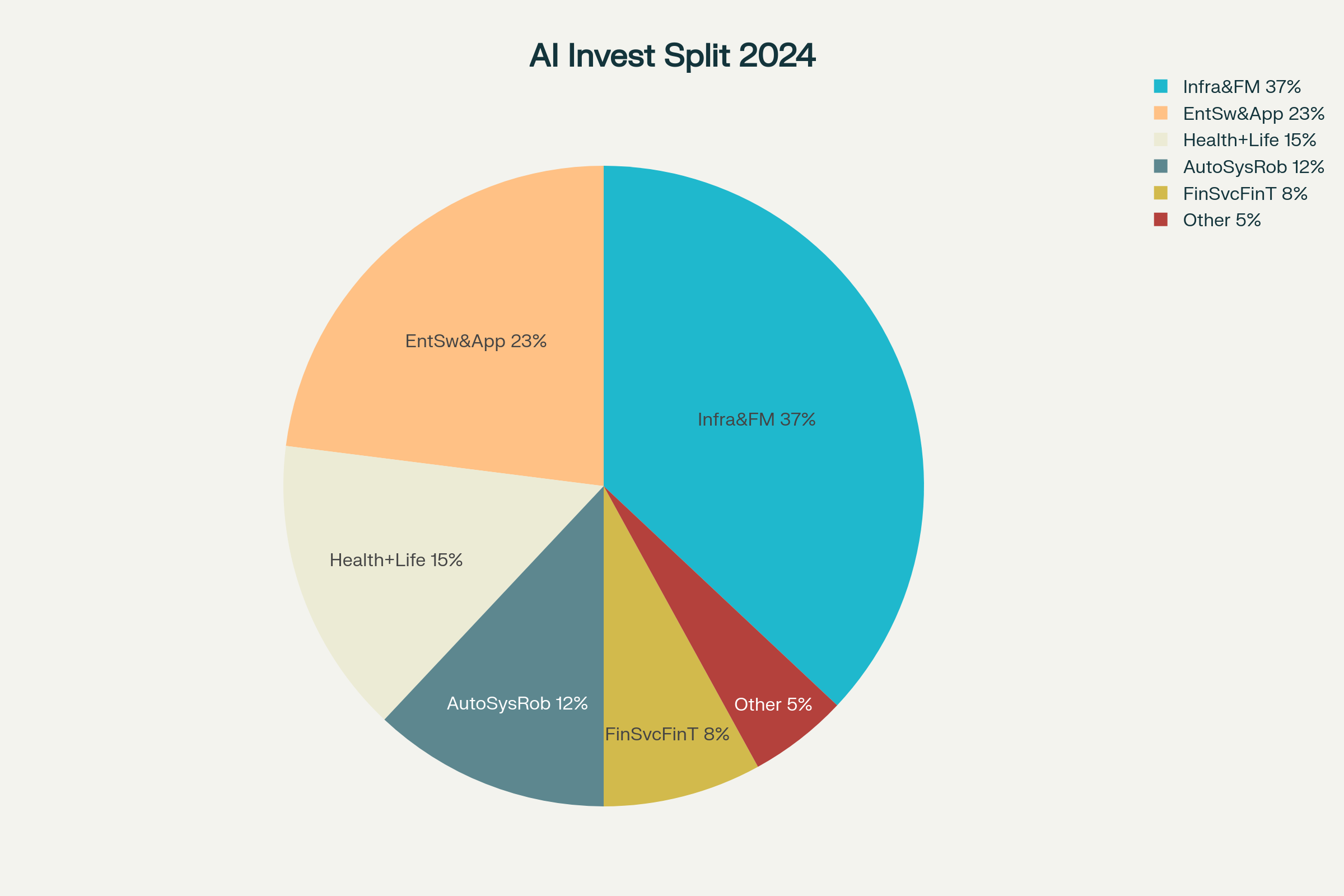
AI Investment Distribution by Sector (2024)
This investment pattern reveals strategic priorities:
- Foundation model development: Companies like OpenAI, Anthropic, and others continue raising massive funding rounds ($6.6 billion for OpenAI, $12 billion for xAI) to advance large language model capabilities
- Enterprise applications: B2B AI solutions are attracting significant investment as organizations seek to integrate AI into existing workflows
- Healthcare innovation: AI-driven diagnostics, drug discovery, and personalized medicine are drawing substantial venture capital
- Autonomous systems: Self-driving vehicles, drones, and robotics represent long-term growth opportunities
Technological Evolution: From Current AI to AGI
The path to Artificial General Intelligence (AGI) is accelerating, with industry experts increasingly converging on timelines within the late 2020s. Multiple AI research organizations and forecasting communities now predict AGI emergence between 2027-2030, a dramatic shortening from earlier decade-long projections8.
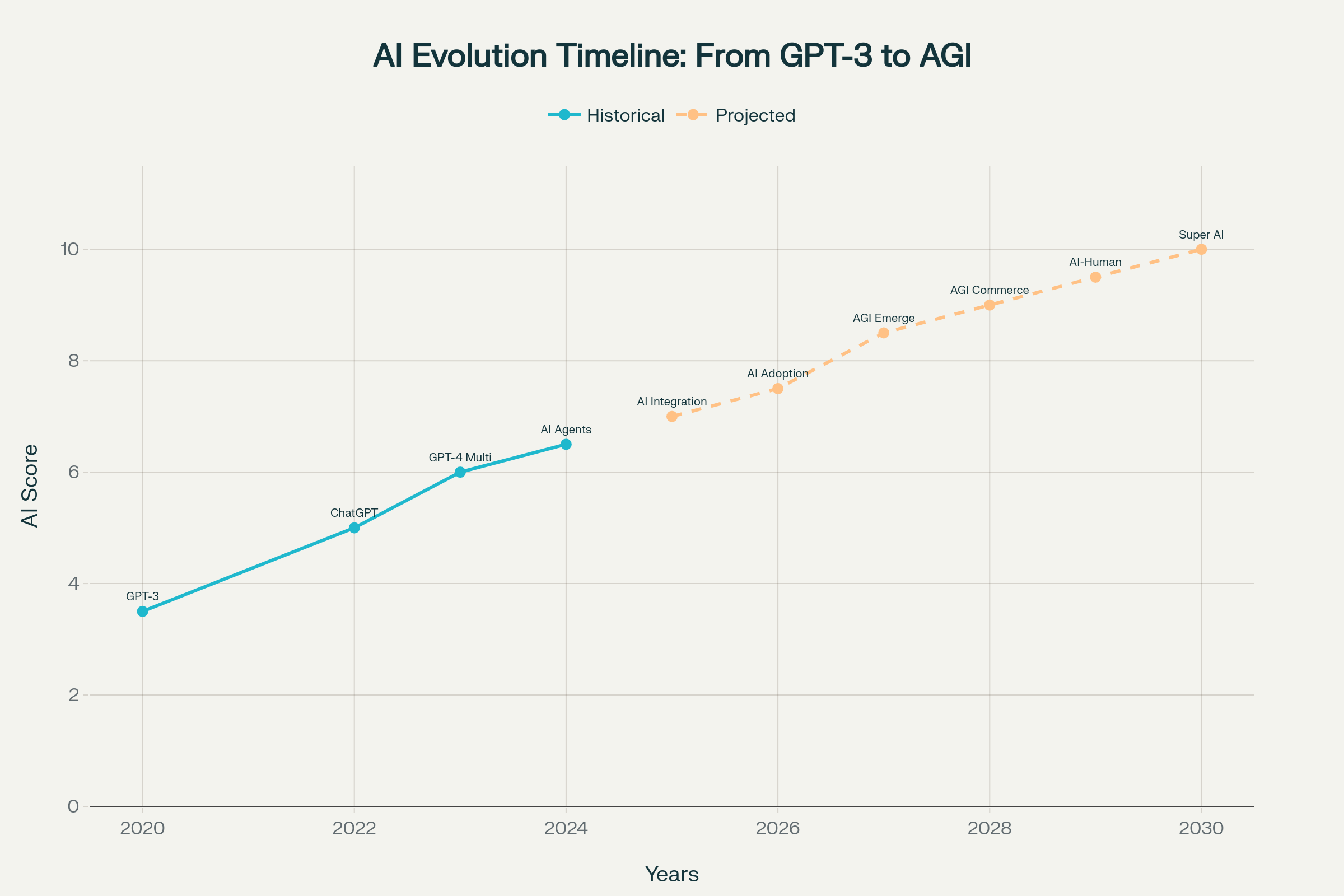
AI Evolution Timeline: From GPT-3 to AGI
Current technological milestones include:
- 2024: Advanced AI agents capable of complex, multi-step reasoning and autonomous task execution
- 2025: Widespread AI integration and optimization across enterprise operations
- 2026: Mainstream adoption of multimodal AI systems combining text, vision, and audio processing
- 2027: Potential emergence of early AGI systems with human-level performance across diverse cognitive tasks
Agentic AI represents the next frontier, with systems transitioning from knowledge-based tools to autonomous agents capable of executing complex workflows without human intervention. Major technology companies are investing heavily in developing AI agents that can interact with their environments, make decisions, and learn from experience.
Sector-Specific Transformations
Healthcare Revolution
AI is revolutionizing healthcare delivery and medical research. Multimodal AI systems now combine medical imaging, electronic health records, and patient data to provide comprehensive diagnostic insights. AI-powered wearable devices offer continuous health monitoring, while personalized medicine algorithms analyze genetic data to create customized treatment plans.
Notable developments include:
- Precision diagnostics: AI systems analyzing medical images with superhuman accuracy
- Drug discovery acceleration: Machine learning reducing pharmaceutical development timelines
- Personalized treatment: Genetic analysis enabling tailored therapeutic approaches
- Remote monitoring: AI-powered devices enabling proactive healthcare interventions
Education and Personalized Learning
AI is transforming educational experiences through personalized learning platforms. These systems analyze individual student performance, learning styles, and preferences to create customized educational pathways. Adaptive learning technologies adjust content difficulty and pacing in real-time, ensuring optimal learning outcomes for each student.
Key educational applications include:
- Intelligent tutoring systems: AI tutors providing 24/7 personalized instruction
- Adaptive assessments: Dynamic testing that adjusts to student performance
- Content customization: Automated generation of learning materials tailored to individual needs
- Performance analytics: Data-driven insights into learning effectiveness
Climate and Sustainability
AI is emerging as a critical tool for climate action, with potential to reduce global emissions by 5.4 gigatonnes CO₂e annually by 2035. Applications span energy optimization, carbon tracking, and environmental monitoring, with AI systems managing complex renewable energy grids and predicting climate patterns with unprecedented accuracy.
Climate applications include:
- Energy optimization: AI managing renewable energy grid stability and distribution
- Carbon tracking: Automated monitoring and reporting of emissions across supply chains
- Weather prediction: Enhanced climate modeling for better disaster preparedness
- Resource management: Optimized allocation of natural resources and waste reduction
Challenges and Ethical Considerations
The rapid advancement of AI brings significant challenges that require careful consideration and proactive management. Privacy concerns, algorithmic bias, job displacement, and the need for transparent AI systems are paramount issues facing the industry.
Key challenges include:
- Ethical AI development: Ensuring fairness, transparency, and accountability in AI systems
- Workforce displacement: Managing the transition as AI automates traditional job functions
- Data privacy: Protecting sensitive information used to train AI models
- Regulatory compliance: Navigating evolving AI governance frameworks globally
- Security vulnerabilities: Protecting AI systems from malicious attacks and misuse
Regulatory frameworks are evolving rapidly, with the European Union’s AI Act setting precedents for risk-based AI regulation, while governments worldwide develop standards for AI safety and governance.
The Quantum-AI Convergence
Quantum computing and AI represent a convergence with transformative potential. Quantum algorithms can optimize complex functions more effectively than classical computers, potentially accelerating machine learning training and enabling breakthrough capabilities in natural language processing and computer vision.
This convergence promises:
- Accelerated machine learning: Quantum algorithms enabling faster AI model training
- Enhanced optimization: Quantum systems solving complex problems intractable for classical computers
- New AI architectures: Quantum-enhanced neural networks with unprecedented capabilities
- Cryptographic implications: Quantum AI systems potentially breaking current encryption methods
Economic and Workforce Implications
AI’s impact on employment is complex and multifaceted. While automation may displace certain job categories, AI is also creating new roles and enhancing human capabilities. The World Economic Forum predicts that AI will disrupt 85 million jobs globally between 2020 and 2025 while creating 97 million new positions.
Workforce transformation includes:
- Job augmentation: AI enhancing human capabilities rather than replacing workers entirely
- New skill requirements: Emphasis on AI literacy, creativity, and complex problem-solving
- Reskilling programs: Organizations investing in employee training for AI-augmented roles
- Human-AI collaboration: Emergence of hybrid work models combining human judgment with AI capabilities
Future Outlook: The Road to 2030
The trajectory toward 2030 suggests an AI-integrated world where intelligent systems are seamlessly embedded in every aspect of human activity. Key developments expected include:
- Ubiquitous AI: AI capabilities integrated into all digital devices and platforms
- Autonomous systems: Self-driving vehicles, delivery drones, and robotic assistants becoming commonplace
- Personalized experiences: AI-driven customization across all service interactions
- Scientific breakthroughs: AI accelerating discovery in medicine, materials science, and energy
- Enhanced human capabilities: Brain-computer interfaces and AI-augmented cognitive abilities
Investment patterns will likely shift toward applied AI solutions and domain-specific applications as foundation models mature. The focus will move from developing core AI capabilities to deploying these technologies for specific use cases and industries.
Conclusion: Embracing the AI-Powered Future
The future with AI represents the most significant technological transformation since the internet revolution. By 2030, AI will be so deeply integrated into our systems and processes that its absence would be inconceivable. Organizations that successfully adapt to this AI-driven landscape will gain unprecedented competitive advantages, while those that resist change risk obsolescence.
Success in the AI era requires strategic planning, ethical consideration, and continuous adaptation. Companies must invest in AI infrastructure, develop workforce capabilities, and establish governance frameworks that ensure responsible AI deployment. The winners will be those who view AI not as a threat to human potential, but as a powerful tool for amplifying human intelligence and creativity.
As we stand at this inflection point, the question is not whether AI will transform our world, but how quickly we can adapt to harness its potential while mitigating its risks. The future with AI is not predetermined—it will be shaped by the choices we make today in research, investment, regulation, and implementation.
The AI revolution is here, and it’s accelerating. Those who embrace this transformation thoughtfully and strategically will be best positioned to thrive in the AI-powered future that awaits.
